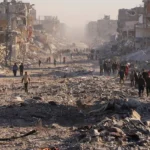
Israeli attacks hit the south and Beqaa, while sources told the press that the Lebanese army will fight alongside Hezbollah if invaded
Massive Israeli air strikes on residential areas in southern and eastern Lebanon killed at least 492 people on Monday (23), in what was described as the bloodiest day in Lebanon in decades.
Among the dead were at least 35 children, 58 women and two rescuers, according to Lebanon’s Health Minister, adding that more than 1,645 people were injured. The attack generated commotion and intensified already growing tensions in the region as the number of victims rose.
One of the airstrikes in southern Beirut targeted Ali Karaki, head of Hezbollah’s southern command, who was in the parking lot of his building, security sources told Reuters. Middle East Eye. Hezbollah later announced that Karaki was alive and had “gone to safety” despite the bombing.
Israeli attacks on Lebanon, focused on Hezbollah positions, have forced tens of thousands of people to flee north in search of safety. The scene of destruction on the roads in the south of the country, covered in ruins and smoke, reflected the chaos that gripped the Lebanese trying to escape the bombings. Israel also contacted several people across the country by telephone, ordering them to leave their homes and flee risk areas.
In response to Israeli bombings, Hezbollah fired a series of rockets at military targets in northern Israel and illegal settlements in the occupied West Bank. This retaliation marked yet another significant escalation in hostilities, further aggravating the confrontation scenario.
Israeli Prime Minister Benjamin Netanyahu declared that “complicated days” were ahead and that he sought to “change the balance of power”. His statements intensified the climate of uncertainty and fear, with Lebanese security sources predicting a worsening of conditions, although they do not expect an Israeli ground invasion, despite the concentration of troops near the border.
“Israel knows that if it infiltrates Lebanon, the Lebanese army and Hezbollah will have military superiority on the ground,” a source told Middle East Eyehighlighting the risk of an even greater confrontation if this eventual invasion occurred.
Furthermore, a source close to Hezbollah stated that the Israeli attacks appear to be aimed at displacing the population of southern Lebanon, in retaliation for Hezbollah attacks in northern Israel, which forced evacuations in the region. Over the weekend, an Israeli minister even suggested that the “enemy Shiite population” of southern Lebanon be expelled and that a buffer zone be created along the border.
As bombings hit southern Lebanon, including areas near major cities like Tyre, residents of Beirut and the south reported receiving phone calls instructing them to stay away from suspected Hezbollah sites. Some Beirut residents also reported receiving text messages from an unknown Lebanese number, ordering them to leave their homes immediately.
Lebanese Information Minister Ziad Makary described these orders as part of “psychological warfare” conducted by Israel. According to the head of telecommunications company Ogero, more than 80,000 phone calls were made to Lebanese instructing them to evacuate. In parallel, Avichay Adraee, Israel’s spokesperson for Arab media, published an animated video on platform X (formerly Twitter), claiming that the Lebanese people knew that Hezbollah weapons were hidden in their homes. The claim was made without evidence and accompanied by further warnings for the Lebanese to flee.
By afternoon, roads leading out of southern Lebanon were clogged with desperate families trying to move north in search of safety. Local media reported chaotic scenes in the city of Saida, where roads were blocked as residents ran to escape shelling. Lebanon’s Interior Ministry announced it had opened schools in Beirut, Tripoli and the eastern and southern parts of the country as emergency shelters as the “massive displacement” of people continued.
Amal Sabbah, a resident of Nabatieh, fled with her family to a shelter on the outskirts of Saida. Their experience reflects the reality of thousands of displaced families who are now trying to take refuge far from areas under attack.
Hezbollah, a movement that grew out of resistance to the Israeli occupation of southern Lebanon between 1982 and 2000, has said it does not seek a full-scale war with Israel but is fighting in solidarity with the Palestinians, who are also under attack in Gaza. A source close to Hezbollah indicated that the organization will maintain its proportional response strategy to Israeli attacks, explaining that “its escalation will correspond to Israel’s level of escalation.” However, Hezbollah has demonstrated some flexibility recently, suggesting that if the attacks on Gaza end without a long-term respite, the current conflict may also come to an end.
In recent weeks, the conflict between Israel and Hezbollah has intensified alarmingly. Earlier Friday, an Israeli airstrike on a densely populated suburb south of Beirut killed 45 people, including several children and women. Hezbollah confirmed that 16 of its members were killed in the attack, including senior leader Ibrahim Aqil and top commander Ahmed Wahbi. The attack came days after a series of Israeli bombings that detonated booby-trapped radios and pagers belonging to Hezbollah members. At least 39 people were killed in these attacks, and more than 3,000 were injured.
Faced with worsening violence, the future of the conflict between Israel and Hezbollah remains uncertain. Security sources and experts warn that although the escalation continues, the chances of a full ground invasion by Israel are still unlikely, given the risk of a devastating confrontation with Lebanese forces and Hezbollah on the ground. However, continued mutual retaliation and increased tensions leave the region on alert, with civilian populations bearing the brunt of this new wave of violence.
With information from Middle East Eye*
Source: https://www.ocafezinho.com/2024/09/24/israel-mata-ao-menos-492-no-libano-e-ordena-fuga-em-massa-de-civis/

